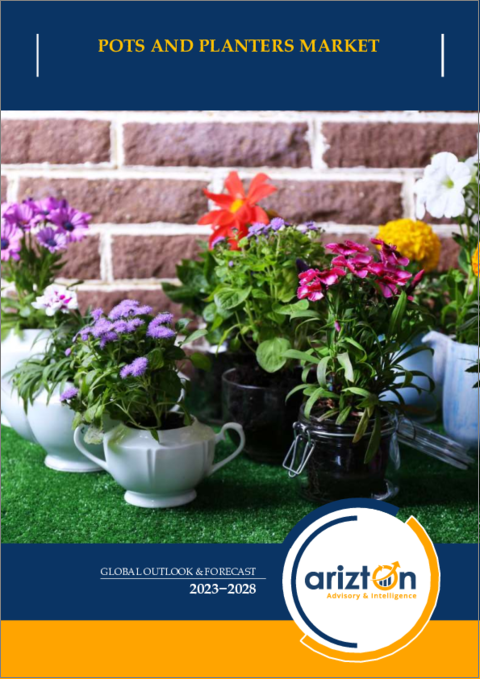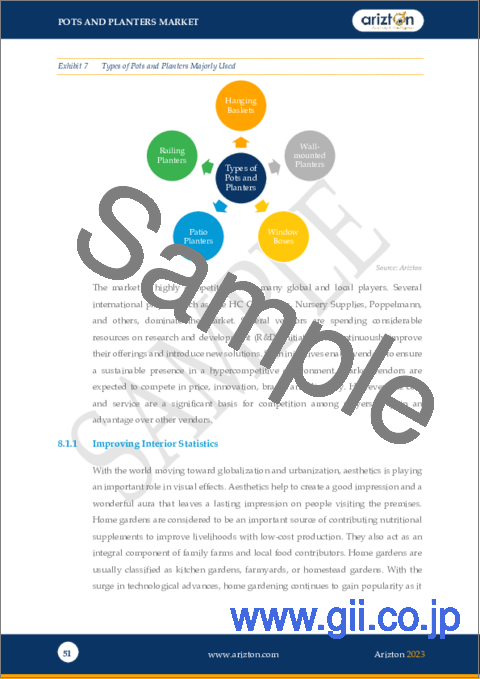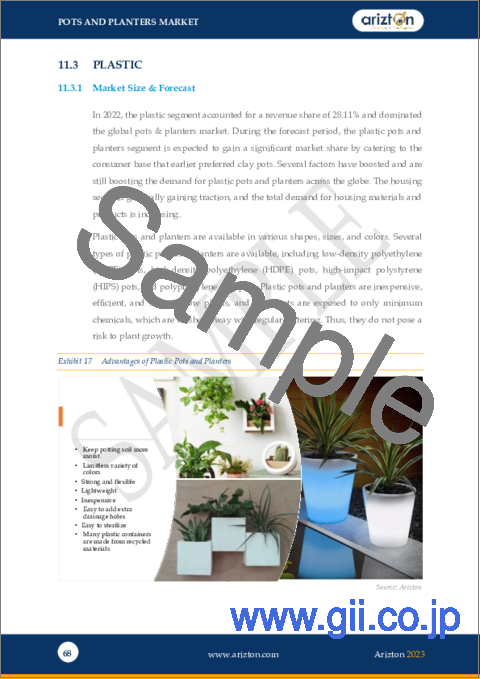|
|
市場調査レポート
商品コード
1306063
鉢・プランター:世界市場の展望・予測 (2023-2028年)Pots and Planters Market - Global Outlook & Forecast 2023-2028 |
||||||
|
|||||||
| 鉢・プランター:世界市場の展望・予測 (2023-2028年) |
|
出版日: 2023年07月12日
発行: Arizton Advisory & Intelligence
ページ情報: 英文 246 Pages
納期: 即納可能
|
- 全表示
- 概要
- 目次
世界の鉢・プランターの市場規模は2022年から2028年にかけて4.64%のCAGRで成長すると予測されています。
材料タイプ別では、プラスチックタイプが2022年に28%超で最大のシェアを示しています。プラスチックタイプには、低密度ポリエチレン (LDPE)、高密度ポリエチレン (HDPE)、高衝撃ポリスチレン (HIPS)、ポリプロピレン (PP) などが含まれています。
当レポートでは、世界の鉢・プランターの市場を調査し、市場の定義と概要、市場機会・市場動向、市場影響因子の分析、市場規模の推移・予測、各種区分・地域別の詳細分析、競合情勢、主要企業のプロファイルなどをまとめています。
目次
第1章 調査手法
第2章 調査目的
第3章 調査プロセス
第4章 調査対象・調査範囲
第5章 レポートの前提・注記
第6章 市場概要
第7章 重要考察
- 市場概要
- 市場力学
- セグメント分析
- 地域分析
- 競合情勢
- 本書について
第8章 イントロダクション
- 概要
- バリューチェーン
- 建設に関する洞察
第9章 市場機会・市場動向
- 垂直庭園の導入の増加
- ウィック システムと自動給水鉢の需要の増加
- 造園サービスとガーデニング製品の急増
- 屋内栽培の増加
第10章 市場成長の実現要因
- 住宅改善プロジェクト
- 商業建設活動の増加
- 急速な都市化
- 持続可能な都市の開発
第11章 市場抑制要因
- 原材料価格の変動
- 競争が激しく細分化された市場
- プラスチック鉢・プランターの使用規定
第12章 市場情勢
- 市場概要
- 市場規模・予測
- ファイブフォース分析
第13章 材料タイプ
- 市場のスナップショット・成長エンジン
- 市場概要
- プラスチック
- セラミック
- 木製
- 金属
- コンクリート
- ガラス繊維
- その他
第14章 用途
- 市場のスナップショット・成長エンジン
- 市場概要
- 住宅
- 商業
- その他
第15章 流通チャネル
- 市場のスナップショット・成長エンジン
- 市場概要
- オフライン
- オンライン
第16章 地域
- 市場のスナップショット・成長エンジン
- 地域概要
第17章 欧州
第18章 北米
第19章 アジア太平洋
第20章 ラテンアメリカ
第21章 中東・アフリカ
第22章 競合情勢
第23章 主要企業プロファイル
- THE HC COMPANIES
- NURSERY SUPPLIES
- POPPELMANN
- KETER
- EAST JORDAN PLASTICS
第24章 他の有力ベンダー
- LANDMARK PLASTIC
- PLANTERS UNLIMITED
- ELHO
- ADO
- AMOP SYNERGIES
- ATECH
- NOVELTY MANUFACTURING
- VERTICAL GREEN
- SERENO
- T.O. PLASTICS
- ANDERSON POTS
- GARANT
- GARDEN NEEDS
- HOSCO
- KINGFISHER DIRECT
- THE GOOD POT CO.
- HORST BRANDSTATTER GROUP
- SCHEURICH
- YORKSHIRE FLOWERPOTS
- STEFANPLAST
第25章 レポート概要
- 重要ポイント
- 戦略的提言
第26章 定量的サマリー
第27章 付録
The global pots and planters market is expected to grow at a CAGR of 4.64% from 2022 to 2028.
MARKET TRENDS & DRIVERS
Growing Adoption of Vertical Gardens
Vertical gardens are increasingly popular for large installations such as apartment buildings, public spaces, and commercial properties. Vertical gardens are one of the best methods to bring nature into urban sector spaces. They offer a wide range of benefits, such as it helps in lowering air pollution since plants filter out dangerous toxins, and they can help improve biodiversity since they offer habitats to various creatures. In cities planting trees is a great way to help safeguard the environment and make it a more pleasant place to live. They can also help lower stress, providing a peaceful and calming atmosphere. Various vertical gardens are available, each providing an exclusive way to grow plants in confined, small spaces. Hydroponic vertical gardens are one of the most common vertical gardens, as instead of soil, they use nutrient-rich water to allow plants to thrive.
Increasing Commercial Construction Activities
The global construction industry is witnessing new developments and market trends. Moreover, technological transformation is a major factor influencing this growth, along with significant changes in design and installation. The growing population, rising demand for public construction activities, and growing investments in renewables and telecommunication are expected to fuel the growth of the construction industry during the forecast period. The commercial sector is witnessing constant growth since 2021 with the reopening of the economy. The construction of hotels, amusement parks, private & government offices, and sports & convention centers is growing, supporting the pots and planters market.
INDUSTRY RESTRAINTS
Variability in Raw Material Prices
Raw material costs comprise 50-60% of the overall cost of production. The quality and lifespan of pots and planters heavily depend on the materials and key raw materials used in designing pots and planters to ensure the product's safety. The prices of major raw materials used to manufacture pots and planters, such as plastic and steel, have been volatile over the last few years. The volatility of raw material prices seriously threatens vendor margins in the global pots and planters market. Other operating expenses, such as labor costs, are also sharply increasing. Chinese manufacturers add more uncertainties to the company's top line. These factors burden vendors striving to produce efficient pots and planters at affordable costs to cope with the competition in the industry.
SEGMENTATION INSIGHTS
INSIGHTS BY MATERIAL TYPE
The plastic material type segment is expected to be the largest in the global pots and planters market, accounting for over 28% share in 2022. Plastic pots and planters are available in various shapes, sizes, and colors. There are several types of plastic pots and planters. Low-density polyethylene (LDPE) pots, high-density polyethylene (HDPE) pots, high-impact polystyrene (HIPS) pots, and polypropylene (PP) pots. During the forecast period, the plastic pots and planters segment is expected to gain a significant industry share by catering to the consumer base that earlier preferred clay pots. Several factors have boosted and are still boosting the demand for plastic pots and planters across the globe. The housing sector is gradually gaining traction, and the total demand for housing materials and products is increasing. Plastic pots and planters are available in various shapes, sizes, and colors.
Segmentation by Material Type
- Plastic
- Ceramic
- Wood
- Metal
- Concrete
- Fiberglass
- Others
INSIGHTS BY APPLICATION
The global pots and planters market by application is segmented into residential, commercial, and others. Presently, homeowners increasingly prefer to design ornamental gardens with lush flora and fauna and fancy pots and planters. Nowadays, with people using pots of different types, gardening is much more than a hobby to enhance the decor of balconies, windows, open spaces, and terraces. Sales of pots and planters are booming in the household sector and are projected to keep growing. The industry outlook is strong in the residential sector, and buyers of all ages are keen to bring green goods home. Also, household pots and planters create a highly visible online presence that has helped build momentum in pots and planters sales.
Segmentation by Application
- Residential
- Commercial
- Others
INSIGHTS BY DISTRIBUTION CHANNEL
The offline distribution channel segment dominated the global pots and planters market in 2022. Offline sales of pots and planters were higher than online sales as consumers prefer to shop for pots and planters in person due to the need for more awareness of the types and sizes of pots. This segment constitutes supermarkets, hypermarkets, and discounters such as Walmart, Lowe's, Costco, Sears, Tesco, Home Depot, and Target, which sell various types of products. Factors such as broader reach in areas that lack better connectivity and high consumer trust associated with personally experiencing the quality of products are driving the growth of this segment.
Segmentation by Distribution Channel
- Offline
- Online
GEOGRAPHICAL ANALYSIS
The global pots and planters market is highly developed in Europe, North America, and APAC owing to the increasing economic development, construction sectors, and tourism sector contributing to the growth of the pots and planters market. On the other hand, Latin America and the Middle East are highly potential markets that help manufacturers to expand their product segments, thereby increasing sales. In 2022, Europe dominated the global pots and planters market. The high demand is attributed to the increased demand for landscaping services due to the widespread green areas across the region. Further, Nordic countries are driving the rapid growth of pots and planters in the next five years. The demand can also be more significant in Western Europe than in Eastern Europe due to the rapid rate of renovation and infrastructure development activities.
Segmentation by Geography
- Europe
- Germany
- The U.K.
- France
- Italy
- Spain
- North America
- The U.S.
- Canada
- APAC
- China
- India
- Japan
- Australia
- South Korea
- Latin America
- Brazil
- Mexico
- Middle East and Africa
- Saudi Arabia
- UAE
- South Africa
COMPETITIVE LANDSCAPE
The global pots and planters market is highly fragmented, with many local and international players. The market is characterized by diversified international vendors and a few regional vendors. Prominent players in the market include The HC Companies, Nursery Supplies, East Jorden Plastics, Poppelmann, and Keter. Manufacturers stress effective ways in which new goods are introduced to produce, assemble, and sell while satisfying customers' different needs and requirements. Major vendors distribute their products via dealers, distributors, mass retailers, and online channels. In addition, these vendors focus on establishing a close partnerships with retailers of pots and planters.
Key Company Profiles
- The HC Companies
- Nursery Supplies
- Poppelmann
- Keter
- East Jordan Plastics
Other Prominent Vendors
- Landmark Plastic
- Planters Unlimited
- elho
- Ado
- Amop Synergies
- ATECH
- Novelty Manufacturing
- Vertical Green
- Sereno
- T.O. Plastics
- Anderson Pots
- Garant
- Garden Needs
- Hosco
- Kingfisher Direct
- The Good Pot Co.
- Horst Brandstatter Group
- Scheurich
- Yorkshire Flowerpots
- Stefanplast
KEY QUESTIONS ANSWERED:
- 1. How big is the pots and planters market?
- 2. What is the growth rate of the global pots and planters market?
- 3. Which region dominates the global pots and planters market share?
- 4. What are the significant trends in the pots and planters industry?
- 5. Who are the key players in the global pots and planters market?
TABLE OF CONTENTS
1 RESEARCH METHODOLOGY
2 RESEARCH OBJECTIVES
3 RESEARCH PROCESS
4 SCOPE & COVERAGE
- 4.1 MARKET DEFINITION
- 4.1.1 INCLUSIONS
- 4.1.2 EXCLUSIONS
- 4.1.3 MARKET ESTIMATION CAVEATS
- 4.2 BASE YEAR
- 4.3 SCOPE OF THE STUDY
- 4.4 MARKET SEGMENTS
- 4.4.1 MARKET SEGMENTATION BY MATERIAL TYPE
- 4.4.2 MARKET SEGMENTATION BY APPLICATION
- 4.4.3 MARKET SEGMENTATION BY DISTRIBUTION CHANNEL
- 4.4.4 MARKET SEGMENTATION BY GEOGRAPHY
5 REPORT ASSUMPTIONS & CAVEATS
- 5.1 KEY CAVEATS
- 5.2 CURRENCY CONVERSION
- 5.3 MARKET DERIVATION
6 MARKET AT A GLANCE
7 PREMIUM INSIGHTS
- 7.1 MARKET OVERVIEW
- 7.2 MARKET DYNAMICS
- 7.2.1 MARKET TRENDS
- 7.2.2 MARKET ENABLERS
- 7.2.3 MARKET RESTRAINTS
- 7.3 SEGMENT ANALYSIS
- 7.4 GEOGRAPHICAL ANALYSIS
- 7.5 COMPETITIVE LANDSCAPE
- 7.6 ABOUT THE REPORT
8 INTRODUCTION
- 8.1 OVERVIEW
- 8.1.1 IMPROVING INTERIOR STATISTICS
- 8.1.2 GROWING DEMAND FOR LIVING WALLS
- 8.2 VALUE CHAIN
- 8.2.1 MATERIAL SUPPLIERS
- 8.2.2 MANUFACTURERS
- 8.2.3 DISTRIBUTORS
- 8.2.4 APPLICATION
- 8.3 CONSTRUCTION INSIGHTS
- 8.3.1 RESIDENTIAL CONSTRUCTION
- 8.3.2 COMMERCIAL CONSTRUCTION
- 8.3.3 PUBLIC INFRASTRUCTURAL CONSTRUCTION
9 MARKET OPPORTUNITIES & TRENDS
- 9.1 GROWTH IN ADOPTION OF VERTICAL GARDENS
- 9.2 INCREASE IN DEMAND FOR WICK SYSTEMS AND SELF-WATERING POTS
- 9.3 SURGE IN LANDSCAPING SERVICES AND GARDENING PRODUCTS
- 9.4 INCREASE IN INDOOR PLANTATION
10 MARKET GROWTH ENABLERS
- 10.1 HOME IMPROVEMENT PROJECTS
- 10.2 INCREASE IN COMMERCIAL CONSTRUCTION ACTIVITIES
- 10.3 RAPID URBANIZATION
- 10.4 DEVELOPMENT OF SUSTAINABLE CITIES
11 MARKET RESTRAINTS
- 11.1 VARIABILITY IN RAW MATERIAL PRICES
- 11.2 HIGHLY COMPETITIVE & FRAGMENTED MARKET
- 11.3 REGULATIONS ON USAGE OF PLASTICS POTS & PLANTERS
12 MARKET LANDSCAPE
- 12.1 MARKET OVERVIEW
- 12.2 MARKET SIZE & FORECAST
- 12.3 FIVE FORCES ANALYSIS
- 12.3.1 THREAT OF NEW ENTRANTS
- 12.3.2 BARGAINING POWER OF SUPPLIERS
- 12.3.3 BARGAINING POWER OF BUYERS
- 12.3.4 THREAT OF SUBSTITUTES
- 12.3.5 COMPETITIVE RIVALRY
13 MATERIAL TYPE
- 13.1 MARKET SNAPSHOT & GROWTH ENGINE
- 13.2 MARKET OVERVIEW
- 13.3 PLASTIC
- 13.3.1 MARKET SIZE & FORECAST
- 13.3.2 MARKET BY GEOGRAPHY
- 13.4 CERAMIC
- 13.4.1 MARKET SIZE & FORECAST
- 13.4.2 MARKET BY GEOGRAPHY
- 13.5 WOOD
- 13.5.1 MARKET SIZE & FORECAST
- 13.5.2 MARKET BY GEOGRAPHY
- 13.6 METAL
- 13.6.1 MARKET SIZE & FORECAST
- 13.6.2 MARKET BY GEOGRAPHY
- 13.7 CONCRETE
- 13.7.1 MARKET SIZE & FORECAST
- 13.7.2 MARKET BY GEOGRAPHY
- 13.8 FIBERGLASS
- 13.8.1 MARKET SIZE & FORECAST
- 13.8.2 MARKET BY GEOGRAPHY
- 13.9 OTHERS
- 13.9.1 MARKET SIZE & FORECAST
- 13.9.2 MARKET BY GEOGRAPHY
14 APPLICATION
- 14.1 MARKET SNAPSHOT & GROWTH ENGINE
- 14.2 MARKET OVERVIEW
- 14.3 RESIDENTIAL
- 14.3.1 MARKET SIZE & FORECAST
- 14.3.2 MARKET BY GEOGRAPHY
- 14.4 COMMERCIAL
- 14.4.1 MARKET SIZE & FORECAST
- 14.4.2 MARKET BY GEOGRAPHY
- 14.5 OTHERS
- 14.5.1 MARKET SIZE & FORECAST
- 14.5.2 MARKET BY GEOGRAPHY
15 DISTRIBUTION CHANNEL
- 15.1 MARKET SNAPSHOT & GROWTH ENGINE
- 15.2 MARKET OVERVIEW
- 15.3 OFFLINE
- 15.3.1 MARKET SIZE & FORECAST
- 15.3.2 MARKET BY GEOGRAPHY
- 15.4 ONLINE
- 15.4.1 MARKET SIZE & FORECAST
- 15.4.2 MARKET BY GEOGRAPHY
16 GEOGRAPHY
- 16.1 MARKET SNAPSHOT & GROWTH ENGINE
- 16.2 GEOGRAPHIC OVERVIEW
17 EUROPE
- 17.1 MARKET SIZE & FORECAST
- 17.2 MATERIAL TYPE
- 17.2.1 MARKET SIZE & FORECAST
- 17.3 APPLICATION
- 17.3.1 MARKET SIZE & FORECAST
- 17.4 DISTRIBUTION CHANNEL
- 17.4.1 MARKET SIZE & FORECAST
- 17.5 KEY COUNTRIES
- 17.5.1 GERMANY: MARKET SIZE & FORECAST
- 17.5.2 UK: MARKET SIZE & FORECAST
- 17.5.3 FRANCE: MARKET SIZE & FORECAST
- 17.5.4 ITALY: MARKET SIZE & FORECAST
- 17.5.5 SPAIN: MARKET SIZE & FORECAST
18 NORTH AMERICA
- 18.1 MARKET SIZE & FORECAST
- 18.2 MATERIAL TYPE
- 18.2.1 MARKET SIZE & FORECAST
- 18.3 APPLICATION
- 18.3.1 MARKET SIZE & FORECAST
- 18.4 DISTRIBUTION CHANNEL
- 18.4.1 MARKET SIZE & FORECAST
- 18.5 KEY COUNTRIES
- 18.5.1 US: MARKET SIZE & FORECAST
- 18.5.2 CANADA: MARKET SIZE & FORECAST
19 APAC
- 19.1 MARKET SIZE & FORECAST
- 19.2 MATERIAL TYPE
- 19.2.1 MARKET SIZE & FORECAST
- 19.3 APPLICATION
- 19.3.1 MARKET SIZE & FORECAST
- 19.4 DISTRIBUTION CHANNEL
- 19.4.1 MARKET SIZE & FORECAST
- 19.5 KEY COUNTRIES
- 19.5.1 CHINA: MARKET SIZE & FORECAST
- 19.5.2 INDIA: MARKET SIZE & FORECAST
- 19.5.3 JAPAN: MARKET SIZE & FORECAST
- 19.5.4 AUSTRALIA: MARKET SIZE & FORECAST
- 19.5.5 SOUTH KOREA: MARKET SIZE & FORECAST
20 LATIN AMERICA
- 20.1 MARKET SIZE & FORECAST
- 20.2 MATERIAL TYPE
- 20.2.1 MARKET SIZE & FORECAST
- 20.3 APPLICATION
- 20.3.1 MARKET SIZE & FORECAST
- 20.4 DISTRIBUTION CHANNEL
- 20.4.1 MARKET SIZE & FORECAST
- 20.5 KEY COUNTRIES
- 20.5.1 BRAZIL: MARKET SIZE & FORECAST
- 20.5.2 MEXICO: MARKET SIZE & FORECAST
21 MIDDLE EAST & AFRICA
- 21.1 MARKET SIZE & FORECAST
- 21.2 MATERIAL TYPE
- 21.2.1 MARKET SIZE & FORECAST
- 21.3 APPLICATION
- 21.3.1 MARKET SIZE & FORECAST
- 21.4 DISTRIBUTION CHANNEL
- 21.4.1 MARKET SIZE & FORECAST
- 21.5 KEY COUNTRIES
- 21.5.1 SAUDI ARABIA: MARKET SIZE & FORECAST
- 21.5.2 UAE: MARKET SIZE & FORECAST
- 21.5.3 SOUTH AFRICA: MARKET SIZE & FORECAST
22 COMPETITIVE LANDSCAPE
- 22.1 COMPETITION OVERVIEW
23 KEY COMPANY PROFILES
- 23.1 THE HC COMPANIES
- 23.1.1 BUSINESS OVERVIEW
- 23.1.2 PRODUCT OFFERINGS
- 23.1.3 KEY STRATEGIES
- 23.1.4 KEY STRENGTHS
- 23.1.5 KEY OPPORTUNITIES
- 23.2 NURSERY SUPPLIES
- 23.2.1 BUSINESS OVERVIEW
- 23.2.2 PRODUCT OFFERINGS
- 23.2.3 KEY STRATEGIES
- 23.2.4 KEY STRENGTHS
- 23.2.5 KEY OPPORTUNITIES
- 23.3 POPPELMANN
- 23.3.1 BUSINESS OVERVIEW
- 23.3.2 PRODUCT OFFERINGS
- 23.3.3 KEY STRATEGIES
- 23.3.4 KEY STRENGTHS
- 23.3.5 KEY OPPORTUNITIES
- 23.4 KETER
- 23.4.1 BUSINESS OVERVIEW
- 23.4.2 PRODUCT OFFERINGS
- 23.4.3 KEY STRATEGIES
- 23.4.4 KEY STRENGTHS
- 23.4.5 KEY OPPORTUNITIES
- 23.5 EAST JORDAN PLASTICS
- 23.5.1 BUSINESS OVERVIEW
- 23.5.2 PRODUCT OFFERINGS
- 23.5.3 KEY STRATEGIES
- 23.5.4 KEY STRENGTHS
- 23.5.5 KEY OPPORTUNITIES
24 OTHER PROMINENT VENDORS
- 24.1 LANDMARK PLASTIC
- 24.1.1 BUSINESS OVERVIEW
- 24.1.2 PRODUCT OFFERINGS
- 24.2 PLANTERS UNLIMITED
- 24.2.1 BUSINESS OVERVIEW
- 24.2.2 PRODUCT OFFERINGS
- 24.3 ELHO
- 24.3.1 BUSINESS OVERVIEW
- 24.3.2 PRODUCT OFFERINGS
- 24.4 ADO
- 24.4.1 BUSINESS OVERVIEW
- 24.4.2 PRODUCT OFFERINGS
- 24.5 AMOP SYNERGIES
- 24.5.1 BUSINESS OVERVIEW
- 24.5.2 PRODUCT OFFERINGS
- 24.6 ATECH
- 24.6.1 BUSINESS OVERVIEW
- 24.6.2 PRODUCT OFFERINGS
- 24.7 NOVELTY MANUFACTURING
- 24.7.1 BUSINESS OVERVIEW
- 24.7.2 PRODUCT OFFERINGS
- 24.8 VERTICAL GREEN
- 24.8.1 BUSINESS OVERVIEW
- 24.8.2 PRODUCT OFFERINGS
- 24.9 SERENO
- 24.9.1 BUSINESS OVERVIEW
- 24.9.2 PRODUCT OFFERINGS
- 24.10 T.O. PLASTICS
- 24.10.1 BUSINESS OVERVIEW
- 24.10.2 PRODUCT OFFERINGS
- 24.11 ANDERSON POTS
- 24.11.1 BUSINESS OVERVIEW
- 24.11.2 PRODUCT OFFERINGS
- 24.12 GARANT
- 24.12.1 BUSINESS OVERVIEW
- 24.12.2 PRODUCT OFFERINGS
- 24.13 GARDEN NEEDS
- 24.13.1 BUSINESS OVERVIEW
- 24.13.2 PRODUCT OFFERINGS
- 24.14 HOSCO
- 24.14.1 BUSINESS OVERVIEW
- 24.14.2 PRODUCT OFFERINGS
- 24.15 KINGFISHER DIRECT
- 24.15.1 BUSINESS OVERVIEW
- 24.15.2 PRODUCT OFFERINGS
- 24.16 THE GOOD POT CO.
- 24.16.1 BUSINESS OVERVIEW
- 24.16.2 PRODUCT OFFERINGS
- 24.17 HORST BRANDSTATTER GROUP
- 24.17.1 BUSINESS OVERVIEW
- 24.17.2 PRODUCT OFFERINGS
- 24.18 SCHEURICH
- 24.18.1 BUSINESS OVERVIEW
- 24.18.2 PRODUCT OFFERINGS
- 24.19 YORKSHIRE FLOWERPOTS
- 24.19.1 BUSINESS OVERVIEW
- 24.19.2 PRODUCT OFFERINGS
- 24.20 STEFANPLAST
- 24.20.1 BUSINESS OVERVIEW
- 24.20.2 PRODUCT OFFERINGS
25 REPORT SUMMARY
- 25.1 KEY TAKEAWAYS
- 25.2 STRATEGIC RECOMMENDATIONS
26 QUANTITATIVE SUMMARY
- 26.1 MARKET BY GEOGRAPHY
- 26.2 EUROPE
- 26.2.1 MARKET BY MATERIAL TYPE
- 26.2.2 MARKET BY APPLICATION
- 26.2.3 MARKET BY DISTRIBUTION CHANNEL
- 26.3 NORTH AMERICA
- 26.3.1 MARKET BY MATERIAL TYPE
- 26.3.2 MARKET BY APPLICATION
- 26.3.3 MARKET BY DISTRIBUTION CHANNEL
- 26.4 APAC
- 26.4.1 MARKET BY MATERIAL TYPE
- 26.4.2 MARKET BY APPLICATION
- 26.4.3 MARKET BY DISTRIBUTION CHANNEL
- 26.5 LATIN AMERICA
- 26.5.1 MARKET BY MATERIAL TYPE
- 26.5.2 MARKET BY APPLICATION
- 26.5.3 MARKET BY DISTRIBUTION CHANNEL
- 26.6 MIDDLE EAST & AFRICA
- 26.6.1 MARKET BY MATERIAL TYPE
- 26.6.2 MARKET BY APPLICATION
- 26.6.3 MARKET BY DISTRIBUTION CHANNEL
- 26.7 MARKET BY MATERIAL TYPE
- 26.7.1 PLASTIC
- 26.7.2 CERAMIC
- 26.7.3 WOOD
- 26.7.4 METAL
- 26.7.5 CONCRETE
- 26.7.6 FIBERGLASS
- 26.7.7 OTHERS
- 26.8 MARKET BY APPLICATION
- 26.8.1 RESIDENTIAL
- 26.8.2 COMMERCIAL
- 26.8.3 OTHERS
- 26.9 MARKET BY DISTRIBUTION CHANNEL
- 26.9.1 OFFLINE
- 26.9.2 ONLINE
27 APPENDIX
- 27.1 ABBREVIATIONS






